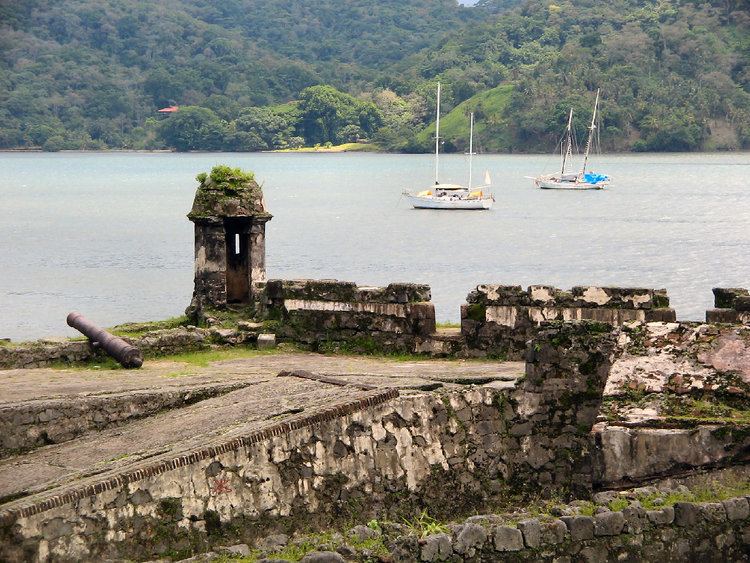Country Panama Founded 1597 | Time zone EST (UTC−5) | |
 | ||
Founded by Francisco Velarde y Mercado Similar Chagres and Fort San Lore, Isla Grande, Iglesia de San Felipe, Panamá Viejo, Gatun Lake | ||
Portobelo is a port city and corregimiento in Portobelo District, Colón Province, Panama with a population of 4,559 as of 2010. It is the seat of Portobelo District. It was established during the Spanish colonial period. Located on the northern part of the Isthmus of Panama, it has a deep natural harbor and was used as a center for silver exporting before the mid-eighteenth century and destruction in the War of Jenkins' Ear.
Contents
Map of Portobelo, Panama
It slowly rebuilt and the city's economy revived briefly in the late nineteenth century during construction of the Panama Canal. But, today Portobelo is a sleepy city with a population of fewer than 5,000. In 1980 the ruins of the Spanish colonial fortifications, along with nearby Fort San Lorenzo, were designated as a UNESCO World Heritage Site, named Fortifications on the Caribbean Side of Panama: Portobelo-San Lorenzo.
Portobelo col n panam prestige panama realty 6981 5000
History
Portobelo was founded in 1597 by Spanish explorer Francisco Velarde y Mercado and quickly replaced Nombre de Dios as a Caribbean port for Peruvian silver. Legend has it that Christopher Columbus originally named the port "Puerto Bello", meaning "Beautiful Port", in 1502. After Francis Drake died of dysentery in 1596 at sea, he was said to be buried in a lead coffin near Portobelo Bay. From the 16th to the 18th centuries, it was an important silver-exporting port in New Granada on the Spanish Main and one of the ports on the route of the Spanish treasure fleets. The Spanish built defensive fortifications.
The privateer William Parker attacked and captured the city in 1601 and Captain Henry Morgan repeated the feat in 1668. He led a fleet of privateers and 450 men against Portobelo, which, in spite of its good fortifications, he captured. His forces plundered it for 14 days, stripping nearly all its wealth while raping, torturing and killing the inhabitants. It was captured again in 1680 by John Coxon
The British had a disaster in the Blockade of Porto Bello under Admiral Hosier in 1726. As part of the campaigns of the War of Jenkins' Ear, the port was attacked on November 21, 1739, and captured by a British fleet of six ships, commanded by Admiral Edward Vernon. The British victory created an outburst of popular acclaim throughout the British Empire. More medals were struck for Vernon than for any other 18th-century British figure. Across the British Isles, Portobello was used in place and street names in honor of the victory, such as Portobello Road in London, the Portobello area in Edinburgh, and the Portobello Barracks in Dublin.
The Spanish quickly recovered the Panamanian town and defeated Admiral Vernon in the Battle of Cartagena de Indias in 1741. Vernon was forced to return to England with a decimated fleet, having suffered more than 18,000 casualties. Despite the Portobello campaign, British efforts to gain a foothold in the Spanish Main and disrupt the galleon trade were fruitless. Following the War of Jenkins' Ear, the Spanish switched from large fleets calling at few ports to small fleets trading at a wide variety of ports, developing a flexibility that made them less subject to attack. The ships also began to travel around Cape Horn to trade directly at ports on the western coast.
Today
Its population as of 1990 was 3,058; its population as of 2000 was 3,867. In July 2012, the UNESCO World Heritage Committee placed Portobelo and nearby Fort San Lorenzo on the List of World Heritage in Danger, inscribed as Fortifications on the Caribbean Side of Panama: Portobelo-San Lorenzo, citing environmental factors, lack of maintenance, and uncontrollable urban developments.
Portobelo is hosting dozen of anchored sail boats. There is an immigration office in the village and boat services taking passengers to Colombia. From $160/person with the taxi boat 'Naturalstour' to $550 on private sail boats.
